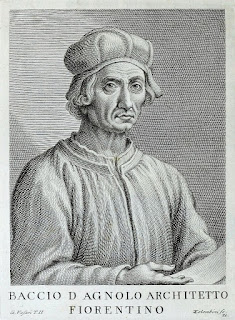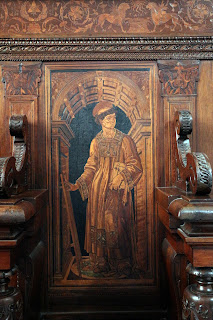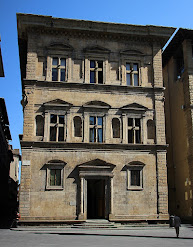Tragic end for the mistress who earned promotion to Grand Duchess
 |
| Bianca Cappello became the mistress of Francesco I |
Grand Duchess Bianca died just one day after her husband, and historians are still divided between the theories that either they were both poisoned, or that they each died of malarial fever.
Bianca had been born in Venice in 1548, the only daughter of a Venetian nobleman, and as she grew up, she was acknowledged to be a great beauty.
At the age of 15, Bianca fell in love with a young Florentine clerk and she eloped with him to Florence, where they were married. She gave birth to a daughter one year later.
The Venetian government tried to have Bianca arrested and brought back to Venice, but Cosimo I, the Grand Duke of Tuscany, intervened on her behalf and she was allowed to stay in Florence. However, she found that she did not get on well with her husband’s family, who, because they had little money, made Bianca do menial work.
Because of her beauty, Bianca attracted the attention of the Grand Prince Francesco, the son and heir apparent of Tuscany’s Grand Duke Cosimo I.
Even though Francesco was married to Joanna of Austria, he seduced Bianca, and as a reward, he gave her money and jewellery as presents. Bianca’s own husband was given employment at the Medici court for a while, until he was murdered in a street in Florence in 1572.
After Francesco became Grand Duke on the death of his father in 1574, he installed Bianca in her own palace, which is now known as Palazzo Bianca Cappello, and he flaunted his mistress in front of his wife.
 |
| Francesco I de' Medici succeeded Cosimo I as Grand Duke of Tuscany |
But after Bianca gave birth to his son, Antonio, in 1576, Francesco refused to acknowledge him, because he was still hoping to have a legitimate heir with his wife, Joanna.
Joanna succeeded in producing a son, Grand Prince Philip de’ Medici, in 1577, crushing Bianca’s hopes of becoming anything more than a mistress who was favoured by Francesco.
However, after Joanna’s death in 1578, Francesco secretly married Bianca, only a few months later.
The marriage was announced publicly in 1579 and Bianca’s son, Antonio, was finally acknowledged as the Duke’s son. Two days later, Bianca was crowned Grand Duchess of Tuscany at Palazzo Vecchio in Florence.
The Venetian government sent a representative to the magnificent, official wedding festivities that were held, because they realised that Bianca Cappello could be useful to them as an instrument for cementing good relations with Tuscany.
But Bianca’s position was still insecure because her son, Antonio, was illegitimate, and he was therefore barred from inheriting the Duchy. She was also aware that if her husband died before she did, she would be lost, because his family all disliked her and regarded her as an interloper.
 |
| Bianca and Francesco's son, Antonio, was born in 1576 |
But on 19 October that year, at the Villa Medicea in Poggio a Caiano, Francesco died. The following day, Bianca also died. Both deaths were believed to be either the result of poisoning, or of malarial fever.
Francesco’s brother did not allow Bianca to be buried in the Medici family tomb, and it is thought that she may have been buried in an unmarked, mass grave under the church of San Lorenzo in Florence.
Bianca’s sad story was used as the basis for a tragic drama, Women Beware Women, written by Thomas Middleton, which was staged for the first time in 1621. She has also been used as a main character in three different novels.
The historic figure of Bianca Cappello was also a main protagonist in The Venetian, a play written by Clifford Vax, which opened in London’s West End in 1931, before moving on to be staged in venues in America.
 |
| The Palazzo Bianca Cappello can be found in Via Maggio in Florence |
The Palazzo Bianca Cappello in Florence's Via Maggio was renovated by Bernardo Buontalenti between 1570 and 1574 at the direction of Grand Duke Francesco I in order to install his lover, Bianca Cappello, in a location close to the Grand Ducal residence of Palazzo Pitti, which was less than 200m (220 yards) away. After Bianca had become Grand Duchess and moved permanently to the Palazzo Pitti, she ceded the palace to the Hospital of Santa Maria Nuova. The palace was linked to the Palazzo Pitti by an underground corridor so that Bianca and Francesco could meet secretly during the time they were lovers. Thanks to this corridor, numerous artworks in the Vasari corridor, the elevated enclosed passageway connecting the Palazzo Vecchio with the Palazzo Pitti, were kept out of the hands of German occupiers in World War Two. Notable for a facade decorated using the sgraffito technique, with images scratched into layers of different coloured plaster, the palace today houses an hotel.
 |
| The Ponte Leopoldo was one of the earliest suspension bridges to be built in Italy |
A settlement since Roman times, Poggio a Caiano is a town of almost 10,000 residents on the banks of the river Ombrone in the Montalbano area northwest of Florence. First the Strozzi and then the Medici families populated the area, an important point of reference for trade and communication. The town is home to the magnificent Villa Medicea, the mansion commissioned by Lorenzo the Magnificent. Built between the 15th and 16th centuries by the architect Giuliano da Sangallo, the Villa Medicea is considered a masterpiece and is a UNESCO World Heritage Site. The villa was the scene of the sudden and mysterious death of Francesco I de' Medici and his second wife Bianca Cappello. Between Poggio and neighbouring Poggetto, the Torrente Ombrone river is crossed by the Ponte Leopoldo, built in 1833 and one of Italy's first suspension bridges.
Also on this day:
1438: The death of sculptor Jacopo della Quercia
1950: The birth of television presenter Mara Venier
1951: The birth of football manager Claudio Ranieri
1962: The birth of jazz musician Dado Moroni













